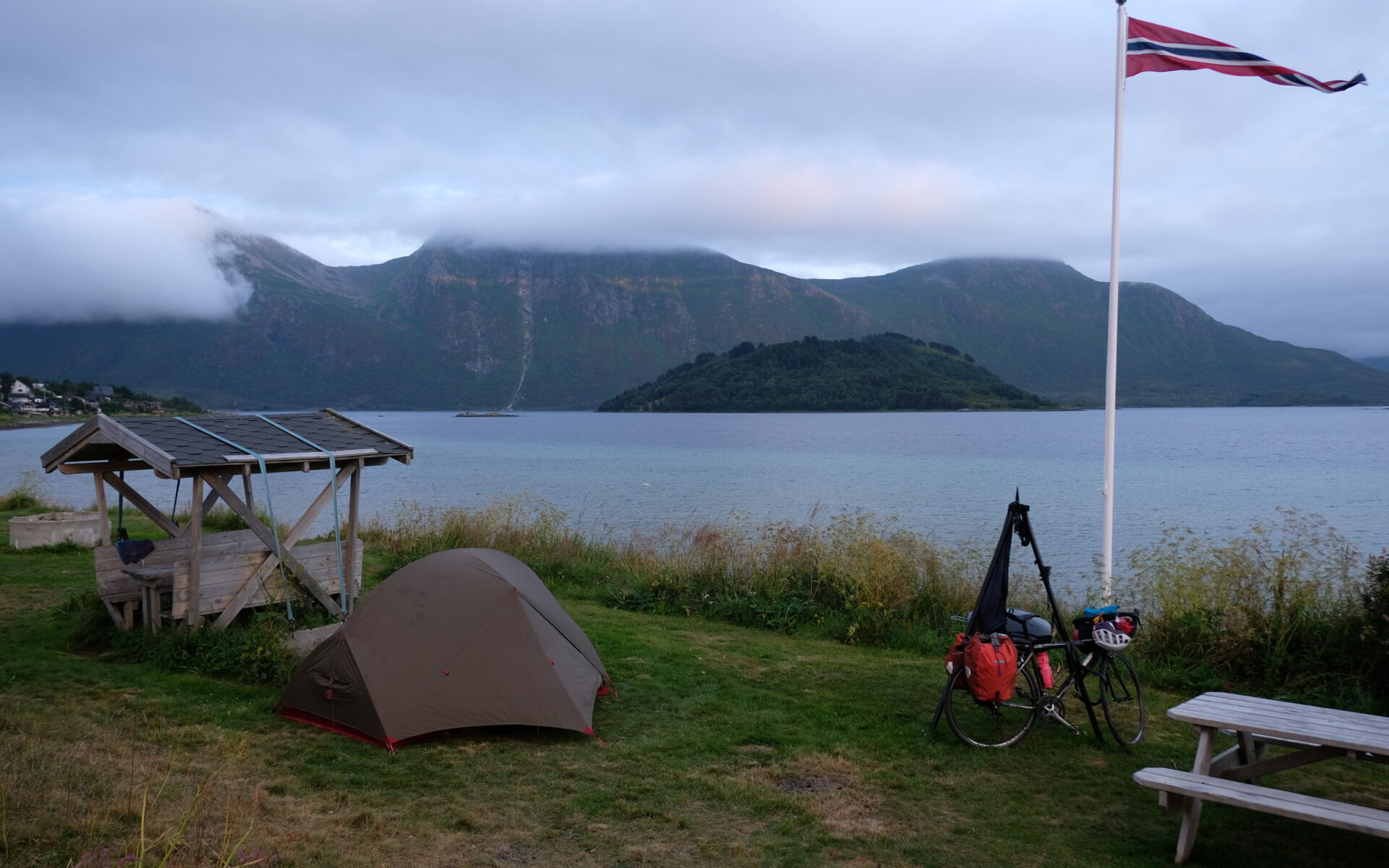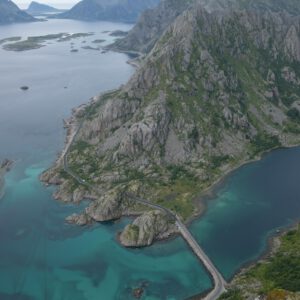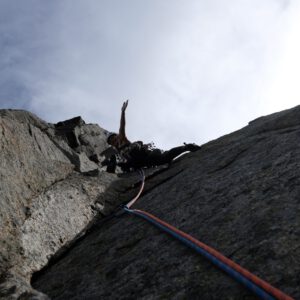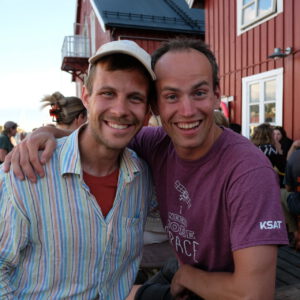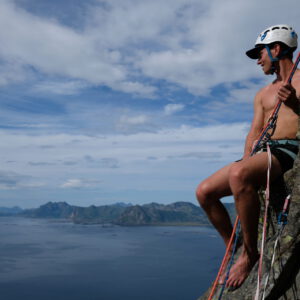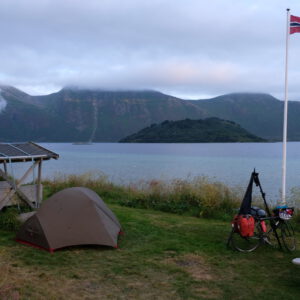Despite my dream to visit the Lofoten for a long time now, I have been tempered by the cost of getting there (carbon footprint wise). After a yearlong of adventuring by bike I felt ready to end my gap year on a high note and travel (solo and slowly) to this remote place. For the sake of simplicity for everyone, I will describe what I think – based on my experience going up and down – is the easiest and most direct way of getting to Lofoten. Although there are beautiful granite walls throughout the archipelago, most of the climbing is centred on Henningsvaer. There are numerous climbing possibilities along the road that winds down to the village, including short and long trad multi-pitch routes; bouldering and sport-climbing sea cliffs. Which makes it very practical for an ecopoint trip.
How to get there
From Central Europe, the full journey can be done in 3 days tops. Depending on where you live, I recommend travelling to Hamburg (Germany). I personally started east of France in Mulhouse.
Here you find what seems to be the most adapted connections while travelling by train with a bike: Mulhouse (France) – Basel (Switzerland) – Hamburg (Germany) – Copenhagen (Denmark) – Malmo (Sweden) – Goteborg (Sweden) – Oslo (Norway) – Trondheim (Norway) – Bodø (Norway) by train. From Bodø, you can take the ferry to Moskenes (at the tip end of Lofoten). The ferries in Norway are considered public transport and they are free of charge for walkers or cyclists. From there, you can either bike to Henningsvaer (130km, 11150 d+), the route you see below. Or you travel on the Lofoten express bus that follows the E10 highway and stops en route. Hitchhiking is also an option and is fairly easy in high season.
Getting to Henningsvaer solely using public transport is also possible. You can either follow the same journey as described above or the following one : Hamburg (Germany) – Stockholm (Sweden) – Narvik (Norway) by train. Narvik – Henningsvaer by bus or hitchhiking.
If you bring the bike, here you find my bike journey from Moskenes to Henningsvaer:
Where to stay
On my way up and down, when going through big cities I used Warmshowers. I also came across the existence of free shelters and primitive (legal) campsite possibilities in Denmark and Sweden thanks to my Warmshowers host in Copenhagen. They are good options if Warmshowers fails and if you don’t want to go for a (paid) campsite.
In Norway, I mainly camped in the wild. Here’s some guidelines about “the right to roam”. I also stayed at the youth hostel HI Bergen Hostel Montana. Here’s a map of the existing HI Norway options.
In the Lofoten, wild camping is possible but overtourism has led to environmental damage in some areas, which has prompted local Lofoten authorities to implement additional restrictions in certain places. For the map that highlights the locations of restricted camping zones, see here.
In Henningsvaer: you can set up a tent everywhere on either the right or left side of the road before reaching the town. At Festvagtind parkering, there were 2 WC and a water pipe to fill up water. There was also water coming out of the big water pipeline on the way to Gandalf Wall.
How to reach the crag(s)
Depending where you set up your tent, it will take you 5 to 15min walk on the road, plus 10 to 30 min on trails to reach the different sectors. There are numerous climbing possibilities, including Presten big wall (The Priest) and other popular areas, such as Gandalf Wall or Festvåg Wall which offer a wide range of short trad climbing multi-pitch routes of varying levels of difficulty.
Tips
If you’re limited on time, and want to go straight in Lofoten to climb : consider using solely public transport ! It will save you some energy on the bike logistics. To plan a long train journey ride, I recommend using the Interrail App or Website. The planner is available even if you don’t buy an interrail deal ! It shows you all the possible connections on the day you wish to travel, and you can save up different alternatives.
If you're NOT limited on time, consider bringing your bike and explore :) I personally had 3 weeks left - after spending a month volunteering in an organic farm near Bergen and - before my interrail pass ended. I took the train direction north and jumped off at Trofors (in the middle of the line Trondheim - Bodø), cycled the Helgeland coast highway v17, eventually reached Bodø and the Lofoten Islands. See here for the gps track.
On the food: There is one small grocery shop (Joker) and numerous restaurants /cafés in Henningsvaer. The closest big supermarket is located in Svolvær (30 km east).
On the climbing: I recommend having a look at the guidebooks that are available to read at the climber’s café Klatrekaféen in the town of Henningsvaer. You can find climbing gear and the guidebooks to buy at the climbing shop Klatrebutikken located just next to the climbing café. I also used Facebook groups (e.g. Lofoten ; Bodø) during my travel to ask for climbing partners and advices. If you want an easier day and still have skin, there are bouldering spots around, like “under Presten”. The app or the website 27crags is a good resource to spot them. You don’t have to buy a membership to access the map or the coordinates.
Others: In Scandinavia, most of the locals speak very well English. But here are a few words you might find useful : Hei ! ; Tak ! ; klatre /klatring ; heftig ! If you find yourself in Henningsvaer end of July /beginning of August there might be a music and culture festival happening.
Tips about travelling on interrail with a bike:
1: It can be tricky during the high season. There are specificities for each country depending on the types of train you take (regional trains, high speed trains, night trains). – i.e. full bikes allowed or not ; number of bike spots available ; prices ; etcetera. This specs are usually specified on the individual company websites. However, I reckon travelling with a dismantled bike in a bag /cover will allow you to get in most trains without paying a supplement. If you have time, access to a sewing machine and want to save up money, consider building yours :) Plenty of DIY tutorials exist on the net. Inspired by this one, I made mine with an old tent material (bought 2€ in a second hand shop) which make it very lightweight and usable for other purposes (e.g. tent footprint /ground cover).
2: If you don’t want to go through the struggle of dismantling your bike : you’ll usually have to buy a bike ticket in order to get onboard with a full bike. If you travel on interrail you won’t be able to do that in advance, and will have to do it on the day at the train station office. Indeed, most of the train company websites offer the possibility to make a bike reservation as an adds-on only when you buy a ticket for yourself. With one exception being Norway. During high season, know that you might not be able to get onboard you planned on first because all the bike spots are sold out. You will have to take the next train or an alternative (longer) road with available spots for your bike. In other words : be flexible !
3: If you want to visit Stockholm on your way up or down travelling with the Stockholm – Narvik night train : you’ll need to book (fairly in advance) an entire sleeper compartment for yourself (and your friends) and your dismantled bike(s) !
How to book the trip
I recommend buying an interrail global pass. The Flexi Pass (5 or 7 days within 1 month ; 10 days within 2 months) is very interesting in terms of money saving and flexibility ! However there are some disadvantages about travelling on interrail : 1) As I mentioned before : you won’t be able to book in advance your bike ticket for most of the EU countries. 2) If you want to travel on a seat, you usually need to buy in advance a supplement for a seat reservation through the train company websites or App (it will be specified when booking the train journey on the Interrail App). If you happen to think about it 24h-48h before, you’ll have to go through calling the customer service (for Scandinavia press 9 to get the menu in English!)
To check the departure times, delay, etcetera (or if you don’t want to travel on interrail), I recommend doing it from the individual train company website or App: SNCF Connect for France, SBB for Switzerland, Deutsche Bahn for Germany, DSB for Denmark, SJ for Sweden, Entur for Norway (I wish every train company websites were as good and well thought /designed !)
Here’s the travel planner for public transport in Lofoten (ferry and bus).

